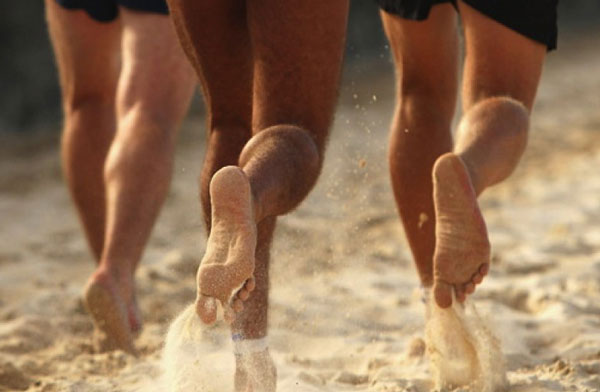Many of us may need to admit to ourselves that running isn’t our best companions. We tend to run at snail-like pace and we get tired too easily. However, many find that shoes that they are wearing are the real culprit. No matter how many shoes they try, it is more comfortable for them to choose the minimalist path by running barefooted. Our ancestors don’t wear shoes and since the introduction of highly supportive, cushioned footwear, people have changed the way they run. We no longer run with that hunter-gatherer style, and our style of running tends to feel more “manufactured”. We could actually reset our running style by doing it barefooted. This should bring us closer to proper ways to run. Healthy running style is actually more relaxed with our body posture set upright.
Then we strike the ground softly with our forefoot. Natural running style is indicated by quick, short strides. The purest form of barefoot running should involve no shoes at all. This method should increase the amount of feedback we get from the ground. We should be able to optimize and adjust our running style, according to the kind of terrain we’re on. This should be achievable to some degree if we wear minimalist running shoes. The whole thing should come from our evolution process. Our bodies, including our feet, are already evolved into an amazing structure that can bend, flex, produce motion and absorb shock. Unfortunately, we tend to weaken our feet by constantly giving them cushioning and support. We inhibit them from performing at their best capacity.

Running is actually a skill and barefoot running is a forgotten skill that we need to re-learn. Just like swimming, running can be potentially dangerous if we don’t learn to do it properly. Regardless of whether we wear footwear or not, running may result in potential injuries. It takes patience and time to learn how to run properly. If we do this correctly, it should be possible to greatly reduce risks associated with barefoot running. Barefoot running should be suitable for everyone, but there are things we need to consider. Whilst everyone is able to run barefoot, there’s no one-style-fits-all. Changing to barefoot running may put more stress to our hamstring, gluteus and lower legs. Our bones, tendons and muscles will also experience greater degree of stress.
Unless we have developed extreme balance, mobility and strength, it is advisable to start with minimally cushioned and slightly more supportive shoes. Once our muscles and bones are more conditioned for barefoot running, then we could move down the scale progressively. Ultimately, the whole thing comes down to our development areas, strengths and individual objectives. We should try to condition the tendons, bones and muscles of our feet. Before we start to run, we could try to walk barefoot for 15 minutes each day. We could try a faster pace when we no longer feel discomfort and pain. In this case, we could start to do shorter barefoot runs.

